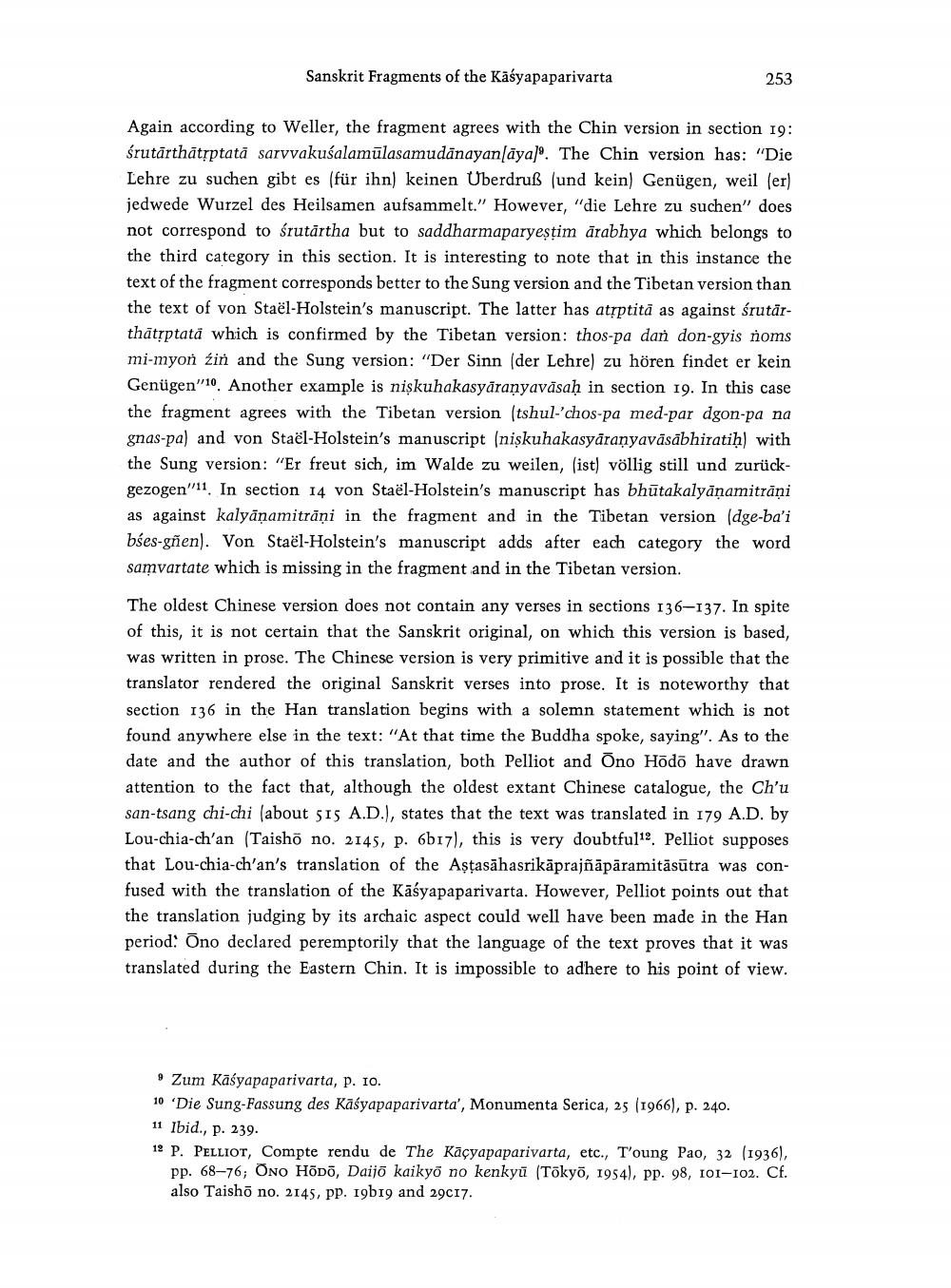________________
Sanskrit Fragments of the Kaśyapaparivarta
253
Again according to Weller, the fragment agrees with the Chin version in section 19: śrutārthātrptatā sarvvakusalamūlasamudānayanļāyal". The Chin version has: "Die Lehre zu suchen gibt es (für ihn) keinen Uberdruß (und kein) Genügen, weil (er) jedwede Wurzel des Heilsamen aufsammelt." However, "die Lehre zu suchen" does not correspond to śrutārtha but to saddharmaparyeștim ārabhya which belongs to the third category in this section. It is interesting to note that in this instance the text of the fragment corresponds better to the Sung version and the Tibetan version than the text of von Staël-Holstein's manuscript. The latter has atịptitā as against śrutārthātņptata which is confirmed by the Tibetan version: thos-pa dan don-gyis noms mi-myon żin and the Sung version: "Der Sinn (der Lehre) zu hören findet er kein Genügen"10. Another example is nişkuhakasyāraṇyavāsaḥ in section 19. In this case the fragment agrees with the Tibetan version (tshul-'chos-pa med-par dgon-pa na gnas-pa) and von Staël-Holstein's manuscript (nişkuhakasyāraṇyavāsābhiratiḥ) with the Sung version: "Er freut sich, im Walde zu weilen, (ist) völlig still und zurückgezogen''11. In section 14 von Staël-Holstein's manuscript has bhūtakalyāṇamitrāņi as against kalyānamitrāni in the fragment and in the Tibetan version (dge-ba'i bấes-gñen). Von Staël-Holstein's manuscript adds after each category the word samvartate which is missing in the fragment and in the Tibetan version. The oldest Chinese version does not contain any verses in sections 136–137. In spite of this, it is not certain that the Sanskrit original, on which this version is based, was written in prose. The Chinese version is very primitive and it is possible that the translator rendered the original Sanskrit verses into prose. It is noteworthy that section 136 in the Han translation begins with a solemn statement which is not found anywhere else in the text: "At that time the Buddha spoke, saying". As to the date and the author of this translation, both Pelliot and Õno Hõdõ have drawn attention to the fact that, although the oldest extant Chinese catalogue, the Ch'u san-tsang chi-chi (about 515 A.D.), states that the text was translated in 179 A.D. by Lou-chia-ch'an (Taisho no. 2145, P. 6b17), this is very doubtful12. Pelliot supposes that Lou-chia-ch'an's translation of the Asțasāhasrikāprajñāpāramitāsūtra was confused with the translation of the Kāśyapaparivarta. However, Pelliot points out that the translation judging by its archaic aspect could well have been made in the Han period: Ono declared peremptorily that the language of the text proves that it was translated during the Eastern Chin. It is impossible to adhere to his point of view.
9 Zum Kaśyapaparivarta, p. 10. 10 'Die Sung-Fassung des Kāśyapaparivarta', Monumenta Serica, 25 (1966), p. 240. 11 Ibid., p. 239. 12 P. Pelliot, Compte rendu de The Kāçyapaparivarta, etc., T'oung Pao, 32 (1936),
pp. 68-76; ONO Hõdo, Daijo kaikyō no kenkyū (Tokyo, 1954), pp. 98, 101-102. Cf. also Taishō no. 2145, pp. 19519 and 29017.




